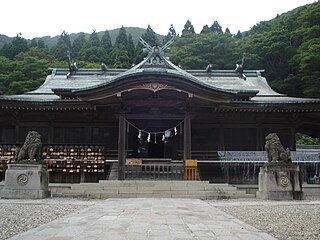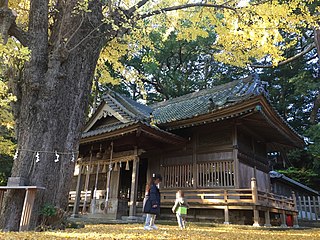
In Japanese religion, Yahata formerly in Shinto and later commonly known as Hachiman is the syncretic divinity of archery and war, incorporating elements from both Shinto and Buddhism.

Iwashimizu Hachimangū (石清水八幡宮) is a Shinto shrine in the city of Yawata in Kyoto Prefecture, Japan.

A Hachiman shrine is a Shinto shrine dedicated to the kami Hachiman. It is the second most numerous type of Shinto shrine after those dedicated to Inari Ōkami. There are about 44,000 Hachiman shrines.

Mitami ShrineMitami-jinja 美多彌神社 is a Shinto shrine in Sakai, Osaka Prefecture, Japan. It is located in Senboku New Town near Komyoike Station. It is accessible on the Nankai bus line or the Semboku Rapid Railway. Mitami-jinja is mentioned in the Heian period chronicle Engishiki compiled in the early tenth century. The shrine buildings were destroyed by Oda Nobunaga's troops in 1577, but they were rebuilt in 1592 by Wada Dosan 和田道讃.

Usa Jingū (宇佐神宮), also known as Usa Hachimangū (宇佐八幡宮), is a Shinto shrine in the city of Usa in Ōita Prefecture in Japan. Emperor Ojin, who was deified as Hachiman-jin, is said to be enshrined in all the sites dedicated to him; and the first and earliest of these was at Usa in the early 8th century. The Usa Jingū has long been the recipient of Imperial patronage; and its prestige is considered second only to that of Ise.

Kagoshima Shrine is a Shinto shrine located in the Hayatomachi-uchi neighborhood of the city of Kirishima, Kagoshima prefecture, Japan. It is the ichinomiya of former Ōsumi Province. The main festival of the shrine are held annually on August 15 by the lunar calendar. Historically it was also known by the names Ōsumi Shō-Hachiman-gū (大隅正八幡宮) and Kokubu Hachiman-gū (国分八幡宮). The shrine precincts was designated as a National Historic Site in 1972.

Kengun Shrine (健軍神社) is the oldest traditional shrine in Kumamoto City, Kumamoto Prefecture, Japan. It is one of the 4 shrines of Aso Shrine group.

Until the Meiji period (1868–1912), the jingū-ji were places of worship composed of a Buddhist temple and a Shinto shrine, both dedicated to a local kami. These complexes were born when a temple was erected next to a shrine to help its kami with its karmic problems. At the time, kami were thought to be also subjected to karma, and therefore in need of a salvation only Buddhism could provide. Having first appeared during the Nara period (710–794), jingū-ji remained common for over a millennium until, with few exceptions, they were destroyed in compliance with the Kami and Buddhas Separation Act of 1868. Seiganto-ji is a Tendai temple part of the Kumano Sanzan Shinto shrine complex, and as such can be considered one of the few shrine-temples still extant.

Watatsu Shrine is a Shinto shrine in the Hamochiiioka neighborhood of the city of Sado, Niigata. It is the ichinomiya of former Sado Province. The main festival of the shrine is held annually on the April 23.

Hakodate Hachiman Shrine is a Shinto shrine located in Hakodate, Hokkaido. It is a Hachiman shrine, dedicated to the kami Hachiman. It is also a Sōja shrine that enshrines all the deities of its region, although it technically does not have a province.

Morioka Hachimangū (盛岡八幡宮) is a Shinto shrine in the city of Morioka, Iwate in northern Japan. The shrine is noted for its annual festival on the second Saturday in June, which is famous for the Chagu Chagu Umakko, a horse parade which was recognized in 1978 as an Intangible Folk Cultural Property. In 1996 the sound of the bells of the Chagu Chagu Umakko was selected by the Ministry of the Environment as one of the 100 Soundscapes of Japan. The shrine is also noted for its displays of yabusame horse archery during its annual festival on September 15.

Tsuboi Hachimangū is a Shinto shrine located in Habikino, Osaka Prefecture, Japan. It is a Hachiman shrine, dedicated to the kami Hachiman. It was established in 1064. Its main festival is held annually on May 15.

Kushihiki Hachimangū is a Shinto shrine located in Hachinohe, Aomori Prefecture, Japan. It is a Hachiman shrine, dedicated to the kami Hachiman. It was established c. 1190-1199. Its main festivals are held annually on April 15 and August 15 according to the lunar calendar, and on May 14. In the former Modern system of ranked Shinto shrines, it was classified as a district shrine.
Ōkaburaya Shrine is a Shinto shrine located in Tamura, Fukushima Prefecture, Japan. It enshrines the kami Takamimusubi (高皇産霊神), Ōkaburaya no kami (大鏑矢神), and Sakanoue Tamuramaro no mikoto (坂之上田村麿命). Its main annual festival is held on November 1.

Koshiō Shrine is a Shinto shrine located in Akita, Akita Prefecture, Japan. It enshrines the kami of Ōhiko no mikoto (大彦命) and Takemikazuchi no mikoto (武甕槌命). Its annual festival takes place on May 8. According to legend, was established in 658.

Fukuyama Hachimangū is a Shinto shrine located in Fukuyama, Hiroshima Prefecture, Japan. It is a Hachiman shrine, dedicated to the kami Hachiman. The kami it enshrines include Emperor Ōjin, Empress Jingū, and Himegami (比売神).
Kameyama Hachimangū is a Shinto shrine located in Shimonoseki, Yamaguchi Prefecture, Japan. It is a Hachiman shrine, dedicated to the kami Hachiman. The kami enshrined there include Emperor Ōjin, Empress Jingū, and Emperor Chūai. It was established in 859, and has an annual festival on October 15.

Kotonomama Hachiman-gū (事任八幡宮) is a Shinto shrine located in the city of Kakegawa, Shizuoka Prefecture, Japan. It is one of two shrines claiming the title of ichinomiya of former Tōtōmi Province, the other being the Oguni Jinja in the town of Mori The shrine's main festival is held annually three days prior to Respect for the Aged Day in September.

Nitta Shrine is a Shinto shrine located in Satsumasendai, Kagoshima Prefecture, Japan. The Nitta Shrine houses two notable subshrines the Nitta Hachimangu, an ichinomiya or a first ranked shrine of its province, and the Shukō Jinja, a Sōja shrine or a shrine that enshrines all the gods of its province.


















